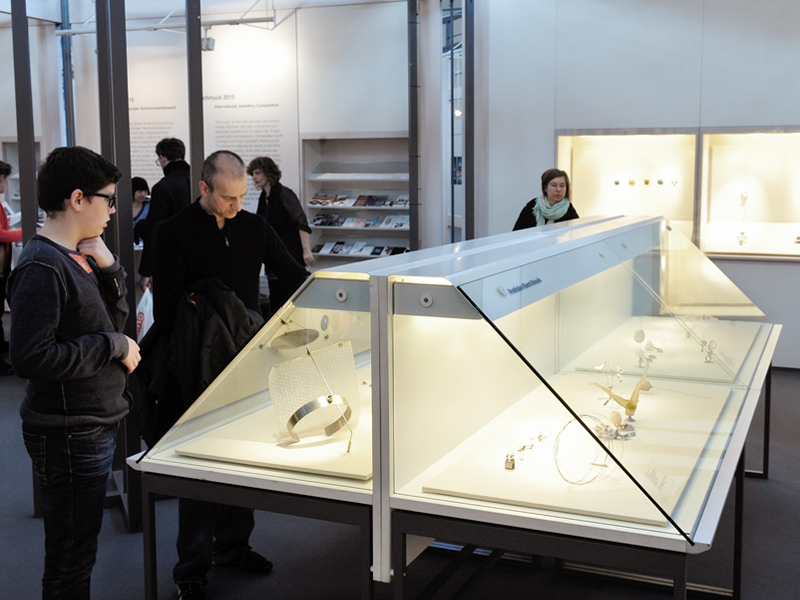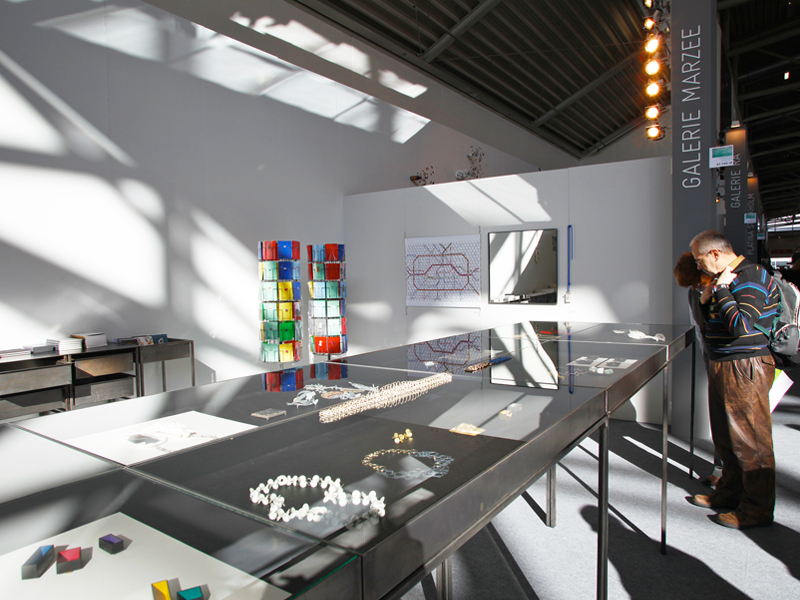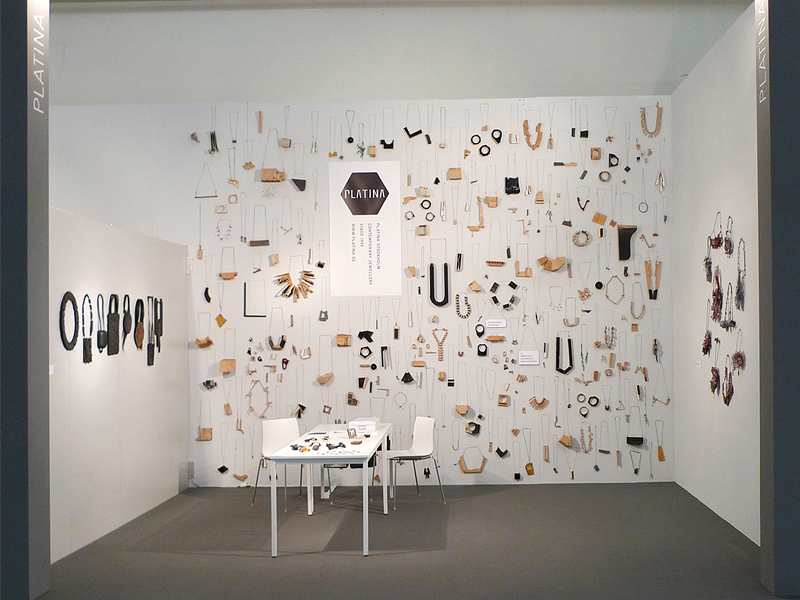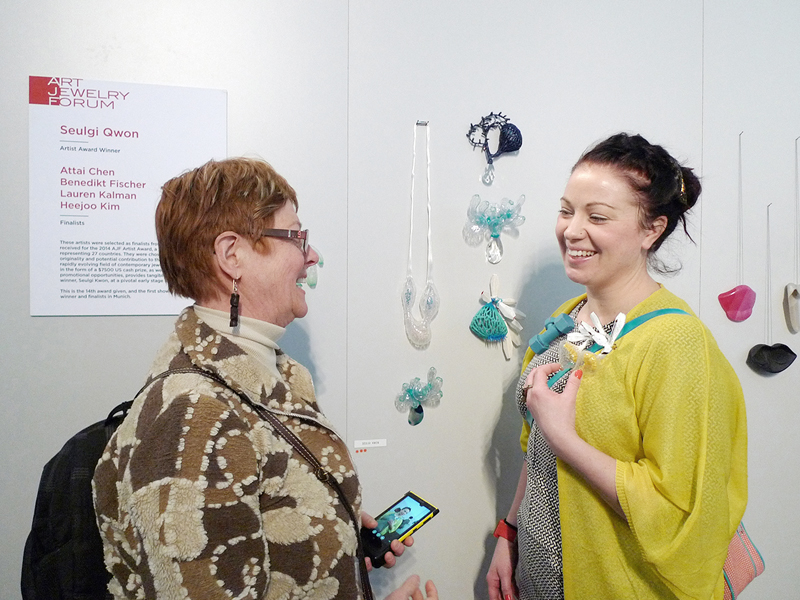
Frame, the small cluster of commercial galleries that surrounds the Talente and Schmuck pavilions at the Munich Handwerksmesse, is welcoming, for this edition, two new galleries: Atta Gallery, from Thailand, and Thomas Cohn, from Brazil.
This expansion of the very successful mini-fair is very good news, and we thought that a quick chat with the person who started it all was long overdue.
Susan Cummins: How long have you been attending Schmuck?
Marie-José van den Hout: Schmuck is an important event in the jewelry world and I visit it as often as I can.
Whose idea was it to add commercial galleries and the bookshop into the mix?
Marie-José van den Hout: It was my idea. In 2008 I talked about it with Wolfgang Lösche, director of Schmuck. He told me to contact Dieter Dohr, the new director of the Handwerksmesse. I had a few meetings with him and he came to visit the gallery in Nijmegen. We agreed that I would make a start for a new small fair in 2009. I invited a few galleries, trying not to overlap representation of artists. Galerie Marzee of course, Galerie Ra, Platina, and there were a few more. I invited Sonia and Michael, from Chrome Yellow, to participate as booksellers. The IHM [Internationale Handwerksmesse Munich.—Ed.] was helpful in every possible way.
What kind of arrangement did you establish with the Handwerkskammer?
Marie-José van den Hout: I think their show should always be the center of the event. The people from the organization are fantastic and what they have achieved is fabulous. Sales of the artists showing at Schmuck go via the gallery that represents the artist.

Who gave it the name Frame?
Marie-José van den Hout: The fair did, and I think it is a good name. A nice frame around this most important jewelry event in the world.
Did you have many sales the first few years?
Marie-José van den Hout: Before you enter Schmuck and Talente, you have to walk through a space with a lot of makers of jewelry, clothes, furniture. Only then do you arrive in a smaller area with a completely different approach to jewelry and objects. You will find art jewelry and objects carefully selected and shown in two great exhibitions, Schmuck and Talente—not makers showing their own work. And galleries representing art jewelry “frame” this event.
Visitors had to get used to us, so in the beginning sales went slow, but every year it got better.
We all feel very supported by the fair organization, which is great and professional, and—very important—they are very open and friendly.

In the beginning, who were your clients?
Marie-José van den Hout: Mostly private collectors from Europe. A lot of them we knew from Collect in London.
If you have museum curators among your clients, why do you think they come to Frame to see and acquire work?
Marie Jose van den Hout: I think because we are professional galleries with a passion for good jewelry; we represent work of the highest quality.
Who are your main clients now? How do sales compare to the past?
Marie-José van den Hout: American collectors are an important group of buyers now. They seem to be very keen on knowing everything about the work they acquire, which I love. Which gallery does not like to talk about the work it represents? And yes, because of the American collectors sales are much better than before. I think this is thanks to AJF, you’re doing a great job here.

The art market, over the past 10 years, has seen a shift to fairs as a source of income. Some galleries do cutting-edge shows during the year, but bring high-end, commercial work to fairs, where they make the bulk of their sales. Is there a similar trend in the jewelry market, and if so, how do you think it is changing the future market?
Marie-José van den Hout: I love to make shows in my gallery; the space is so amazing and you can show work which in a fair you would never be able to show.
At fairs I show the work I showed in the gallery since the last fair, so there is always an overview of the most recent work, that is, of the last 12 months. Of course I also bring easier-to-sell work, but I try to be as “Marzee” as I can be.
What are your main platforms for selling, and what do you think would help strengthen this market? More fairs, more shows, more auctions?
Marie-José van den Hout: My main platforms for selling are fairs. This is the trend, this is where people go to see a lot of work in one big venue; sometimes it makes me feel like a traveling circus.
Who will be exhibiting at Frame this year?
Marie-José van den Hout: Galerie Ra, Platina, Rosemarie Jäger, Thomas Cohn, Atta Gallery, and myself of course. Atty Tantivit of Atta Gallery I invited a few years ago. I asked her to bring artists from her country and she managed to bring a group of Thai artists together. I am really happy about that.
Thank you.





